VERB PHRASES
The basic structure of verb phrases
Remember the sentence, The little boy laughed? As we talked about earlier, The little boy is a noun phrase and laughed is a verb phrase. There are different kinds of verb phrases, and we can begin to discover them by seeing what we can substitute for the verb phrase, laughed, in this sentence. The underlined portions of the sentences below are all verb phrases, and any one of them can replace laughed in the sentence, The little boy laughed.
1. The little boy left.
2. The little boy chased the ball.
3. The little boy chased the red ball.
4. The little boy chased it.
5. The little boy chased Henry.
Of course, there are lots of things that cannot replace laughed in this sentence, for example:
6. *The little boy his extremely.
7. *The little boy near from.
8. *The little boy they.
You’re probably not surprised to learn that his extremely, near from, and they are not verb phrases.
Have you noticed anything that all the underlined verb phrases in sentences 1-5 have in common? Each verb phrase has a verb. In fact, in sentence 1, the verb phrase has nothing in it but a verb, left. A verb phrase may also have other words, as you can see in sentences 2-5, but the least that every verb phrase has to have is a verb.
Quick tip
Every verb phrase contains a verb, for example laughs, left.
In sentences 1-5, the verb is the first word in the verb phrase and is its most Important part.

Answers
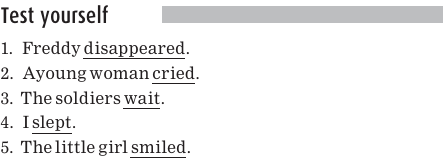
If we look at sentences 2-5, we see that a verb phrase can have more in it than just a verb. Let’s start with sentence2, The little boy chased the ball. The verb phrase is:
9. chased the ball (verb+determiner+noun)
You may remember that determiner + noun is a kind of noun phrase. Thus, in this sentence, the verb phrase consists of a verb followed by one kind of noun phrase.
Let’s look at the verb phrases in sentences3-5:
10. chased the red ball (verb + determiner + adjective + noun)
11. chased it (verb + pronoun)
12. chased Henry (verb+noun)
You can see that in each case, the verb phrase consists of a verb followed by a noun phrase.
Quick tip
A verb phrase can consist of a verb plus a noun phrase, for example chased the ball.
Again, we don’t have to list the different kinds of noun phrases here, we can just refer to noun phrases in general.

Answers


Answers

We talked about the fact that some verbs are action verbs, like run, write, and discover, while others are linking verbs, like be, feel, and become. The verb phrases we’ve looked at so far have all contained action verbs. Verb phrases with linking verbs are different from verb phrases with action verbs. Let’s compare two sentences:
11. John saw the teacher.
12. John is the teacher.
In each sentence, the verb phrase is underlined, and each verb phrase consists of a verb+ noun phrase. (Saw and is are the verbs and the teacher is the noun phrase.) But can you see how the verb phrases in sentences11 and 12 differ? You’ve probably noticed that in sentence 11, the teacher is receiving the action, but in sentence 12, there is no action (after all, is is a linking verb, not an action verb). So while the structures of sentences 11 and 12 appear to be similar on the surface, the sentences are quite different in meaning.
The following verb phrases with linking verbs are different in structure as well as in meaning from verb phrases with action verbs:
13. John is tall.
14. My sister became anxious.
As you (hopefully!) remember, tall and anxious are adjectives. So, when the verb is a linking verb, it can be followed by an adjective alone. An action verb cannot be followed by just an adjective, as you can see:
15. *John saw tall.
16. *John saw upset.
Quick tip
A verb phrase can consist of a linking verb plus an adjective, for example is tall.
An adjective which follows a linking verb and is not part of a noun phrase is traditionally called a predicate adjective, as in the example John is tall (sentence13). In contrast, an adjective which is part of a noun phrase is traditionally called an attributive adjective, as in the example John has a tall sister.
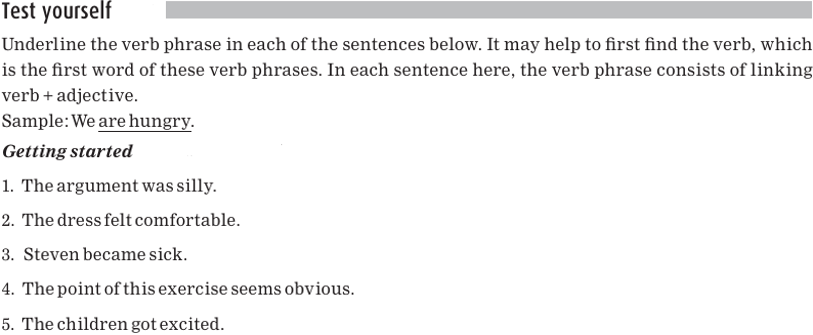
Answers


Answers


Answers


Answers

To enhance your understanding
You may remember, that some verbs, for example smell, can be used as either action verbs or linking verbs. For example:
17. That dog smells badly. (Meaning, he does a bad job of smelling things.)
18. That dog smells bad. (Meaning, for example, he needs a bath.)
In sentence 17, smell is an action verb; it refers to the dog doing the action of smelling. In sentence 18, smell is a linking verb; it helps to tell us something about the dog but he’s not actually doing anything – he’s being something, namely, smelly.
When a verb is used as a linking verb, it can have an adjective, like bad, after it. When it’s used as an action verb, it can be followed by an adverb, like badly, but not by an adjective.
In Standard American English, good is used only as an adjective. So, in Standard American English, it’s not considered acceptable to say:
19. You did good.
That’s because did is an action verb, and an action verb cannot be completed with just an adjective. So why do we often hear people saying sentences like You did good? What’s happening is that people are starting to use good as an adverb, not just as an adjective.
Maybe in the future this usage will become more widely accepted, but right now using good as an adverb is not considered Standard American English. (In other words, don’t say this at a job interview, although it’s fine to say with friends.)
Similarly, people sometimes say, I feel badly, instead of I feel bad, even though they are using feel here as a linking verb, not as an action verb. They know that usually an adverb, like badly, follows a verb, but adverbs only directly follow action verbs, not linking verbs.
(When people in correctly over apply a rule, it’s called hypercorrection.)
We can thus explain the difference between I feel good (‘‘I’m OK’’) and I feel well (‘‘I have the ability to touch effectively’’): in the former sentence feel is a linking verb, in the latter it is an action verb.
We talked about prepositional phrases. Here are some sentences with their verbs in bold and their prepositional phrases underlined:
20.The Bede family lives around the corner.
21. Please ride to the stable.
22.He headed toward the policeman.
Together, the verb plus prepositional phrase form a verb phrase.
Quick tip
A verb phrase can consist of a verb plus a prepositional phrase, for example drove to the mall.
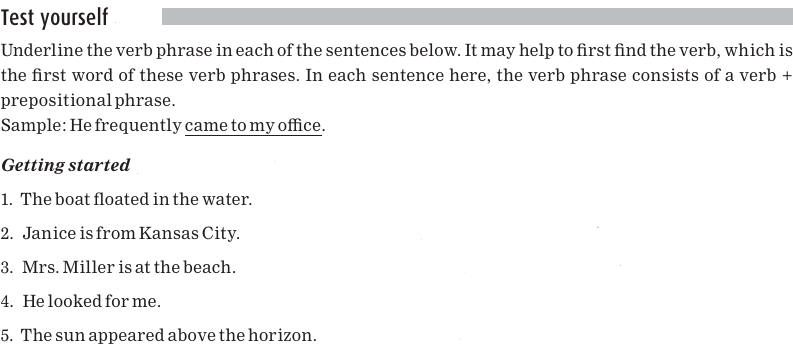
Answers

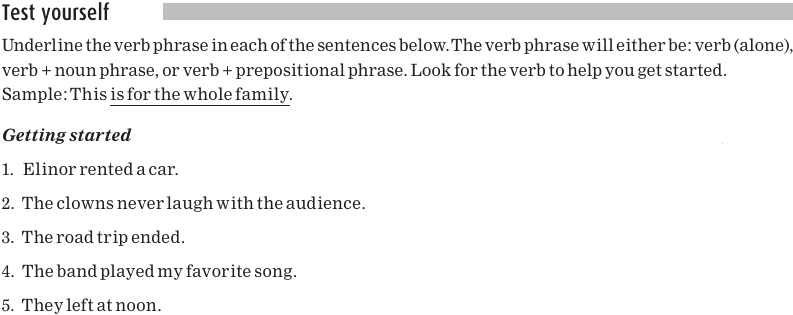
Answers

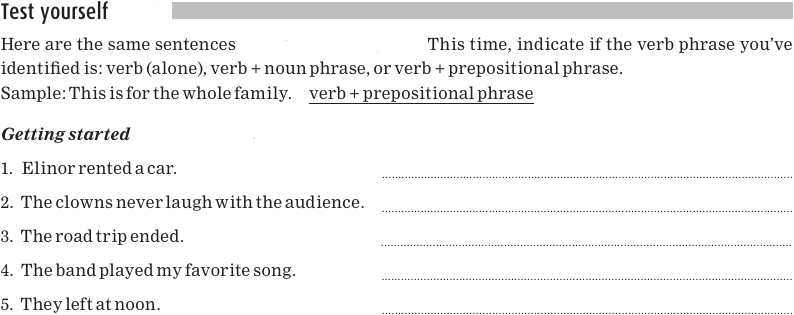
Answers


Answers

Can a verb phrase have a verb followed by both a noun phrase and a prepositional phrase?
23. He walked Mary to the corner.
24. The dog chased the man with the umbrella.
In these sentences, the verb phrase consists of a verb followed by a noun phrase and also a prepositional phrase.
Quick tip
A verb phrase can consist of a verb plus a noun phrase plus a prepositional phrase, for example drove her friend to the mall.
Can we say the following?
25. *He walked to the corner Mary.
26. *The dog chased with the umbrella the man.
These sentences show us that when a verb is followed by a noun phrase and a prepositional phrase, the noun phrase always has to be before the prepositional phrase.

Answers

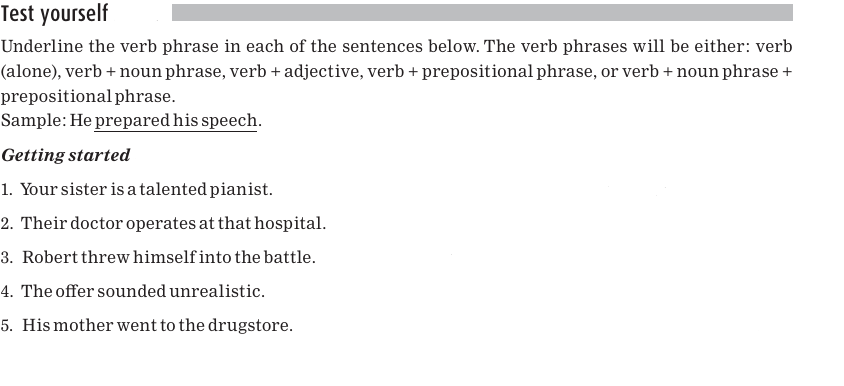
Answers

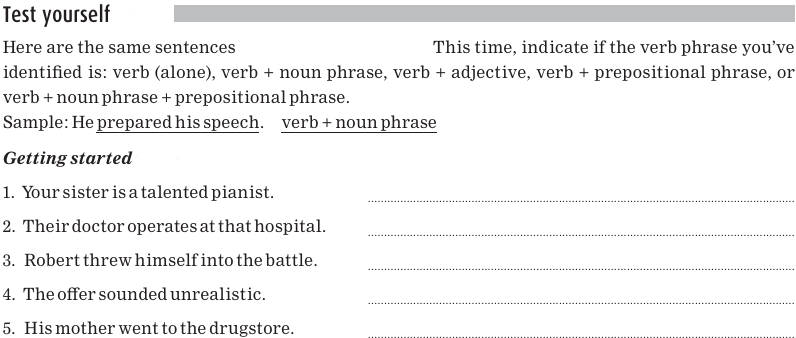
Answers

To sum up, we list below the kinds of verb phrases we’ve discussed:

While there are more kinds of verb phrases, what we’ve done here is to show you some basic ones.
 الاكثر قراءة في Phrases
الاكثر قراءة في Phrases
 اخر الاخبار
اخر الاخبار
اخبار العتبة العباسية المقدسة


